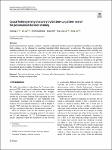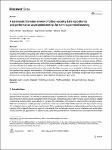Search
Author
- Jorgensen, Ed (3)
- McFadyen, Ron (3)
- Nora, El-Rashidy (3)
- Christian, Homeyer (2)
- next >
Subject
- programming (10)
- Open Access (8)
- Java (7)
- Programming (7)
- next >
Date issued
- 2020 - 2025 (293)
- 2010 - 2019 (39)
- 2000 - 2009 (2)
- 1999 - 1999 (1)
Has File(s)
- true (335)
Search Results
Heterogeneous computing is the major driving factor in designing new energy-efficient high-performance computing systems. Despite the broad adoption of GPUs and other specialized architectures, the interest in spatial architectures like field-programmable gate arrays (FPGAs) has grown. While combining high performance, low power consumption and high adaptability constitute an advantage, these devices still suffer from a weak software ecosystem, which forces application developers to use tools requiring deep knowledge of the underlying system, often leaving legacy code (e.g., Fortran applications) unsupported. |
Zero-shot learning (ZSL) aims at recognizing classes for which no visual sample is available at training time. To address this issue, one can rely on a semantic description of each class. A typical ZSL model learns a mapping between the visual samples of seen classes and the corresponding semantic descriptions, in order to do the same on unseen classes at test time. State of the art approaches rely on generative models that synthesize visual features from the prototype of a class, such that a classifier can then be learned in a supervised manner. However, these approaches are usually biased towards seen classes whose visual instances are the only one that can be matched to a given class prototype. |
Coronavirus Disease 2019 (COVID-19), which is caused by Severe Acute Respiratory Syndrome Coronavirus 2 (SARS-COV-2), surprised the world in December 2019 and has threatened the lives of millions of people. Countries all over the world closed worship places and shops, prevented gatherings, and implemented curfews to stand against the spread of COVID-19. Deep Learning (DL) and Artificial Intelligence (AI) can have a great role in detecting and fighting this disease. Deep learning can be used to detect COVID-19 symptoms and signs from different imaging modalities, such as X-Ray, Computed Tomography (CT), and Ultrasound Images (US). This could help in identifying COVID-19 cases as a first step to curing them. In this paper, we reviewed the research studies conducted from January 2020 t... |
In personalised decision making, evidence is required to determine whether an action (treatment) is suitable for an individual. Such evidence can be obtained by modelling treatment effect heterogeneity in subgroups. The existing interpretable modelling methods take a top-down approach to search for subgroups with heterogeneous treatment effects and they may miss the most specific and relevant context for an individual. In this paper, we design a Treatment effect pattern (TEP) to represent treatment effect heterogeneity in data. To achieve an interpretable presentation of TEPs, we use a local causal structure around the outcome to explicitly show how those important variables are used in modelling. We also derive a formula for unbiasedly estimating the Conditional Average Causal Effe... |
The advent of the Big Data era has brought considerable challenges to storing and managing massive data. Moreover, distributed storage systems are critical to the pressure and storage capacity costs. The Ceph cloud storage system only selects data storage nodes based on node storage capacity. This node selection method results in load imbalance and limited storage scenarios in heterogeneous storage systems. Therefore, we add node heterogeneity, network state, and node load as performance weights to the CRUSH algorithm and optimize the performance of the Ceph system by improving load balancing. We designed a cloud storage system model based on Software Defined Network (SDN) technology. |
Developing Graphics Frameworks with Python and OpenGL shows you how to create software for rendering complete three-dimensional scenes. The authors explain the foundational theoretical concepts as well as the practical programming techniques that will enable you to create your own animated and interactive computer-generated worlds. You will learn how to combine the power of OpenGL, the most widely adopted cross-platform API for GPU programming, with the accessibility and versatility of the Python programming language. Topics you will explore include generating geometric shapes, transforming objects with matrices, applying image-based textures to surfaces, and lighting your scene. Advanced sections explain how to implement procedurally generated textures, postprocessing effects, and ... |
This is an open access book that covers the complete set of experiences and results of the FemTech.dk research which we have had conducted between 2016-2021 – from initiate idea to societal communication.
Diversity in Computer Science: Design Artefacts for Equity and Inclusion presents and documents the principles, results, and learnings behind the research initiative FemTech.dk, which was created in 2016 and continues today as an important part of the Department of Computer Science at the University of Copenhagen’s strategic development for years to come. FemTech.dk was created in 2016 to engage with research within gender and diversity and to explore the role of gender equity as part of digital technology design and development. FemTech.dk considers how and why computer science ... |
In Machine Learning, the datasets used to build models are one of the main factors limiting what these models can achieve and how good their predictive performance is. Machine Learning applications for cyber-security or computer security are numerous including cyber threat mitigation and security infrastructure enhancement through pattern recognition, real-time attack detection, and in-depth penetration testing. Therefore, for these applications in particular, the datasets used to build the models must be carefully thought to be representative of real-world data. |
People use various nonverbal communicative channels to convey emotions, among which facial expressions are considered the most important ones. Thus, automatic Facial Expression Recognition (FER) is a fundamental task to increase the perceptive skills of computers, especially in human-computer interaction. Like humans, state-of-art FER systems are able to recognize emotions from the entire face of a person. |
The analysis of linear ill-posed problems often is carried out in function spaces using tools from functional analysis. However, the numerical solution of these problems typically is computed by first discretizing the problem and then applying tools from finite-dimensional linear algebra. The present paper explores the feasibility of applying the Chebfun package to solve ill-posed problems with a regularize-first approach numerically. This allows a user to work with functions instead of vectors and with integral operators instead of matrices. The solution process therefore is much closer to the analysis of ill-posed problems than standard linear algebra-based solution methods. |










